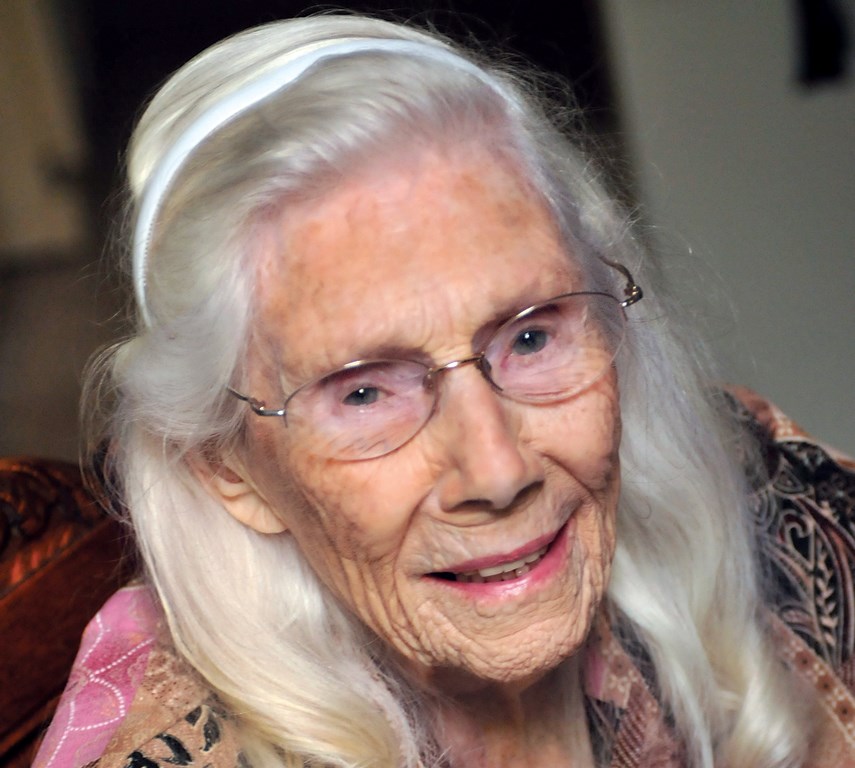If one day this fall you take a walk along Mackay Creek Park – to breathe the clean air of the forest and the creek, to enjoy walking on soft ground instead of everlasting concrete (we call this forest bathing these days) – you will cross a wooden bridge named for June Smith, a gift of thanks from her friends and neighbours.
A North Vancouver resident for almost 70 years, June celebrated her 100th birthday this month in the company of those friends and neighbors.
“I don’t know why there was such a fuss,” she says. “Not everybody gets to 100, I guess. It’s lovely to have good friends, and it was a wonderful party, just a real pleasure.”
Friends and neighbours came to mark the occasion of June’s centenary, and to recognize the contributions she and her husband, Earl, made to their community.
For that story, let’s go back 100 years.
June Taylor was born Sept. 13, 1919. The family lived in Mimico, on the outskirts of Toronto. The setting was rural enough to accommodate four children, assorted cats and dogs, and a menagerie of turtles, guineas pigs and rabbits.
“My dad loved nature and animals and kept bringing them home to us. He was the best dad ever, full of fun, making up games and taking us on adventures,” she explains.
Having a love of animals and nature goes as far back as June can remember – and her memory is remarkable. The natural world is part of her story, like walking over a mile to school, bundled into long underwear and galoshes in winter, and enjoying the sweet relief of socks and shoes when winter finally went away.
June was 22 years old when she married Earl Smith, a newspaper man like his father. They decided to go out west, having heard that “Vancouver was nice.” It was. But maybe North Vancouver would be even nicer.
“We kept hearing on the radio, ‘Come on to Capilano Highlands,’ so one weekend, over we went to North Vancouver,” says Smith.
The scent of the clean air and the earth and the trees convinced June and Earl to buy a lot in the new subdivision. Many a weekend they picnicked on the site of their future home.
A hand drawn “For Sale” sign posted on a nearby lot led the Smiths to consider that this lot might be nicer than their own. About five acres in total, it extended down through the forest to Mackay Creek.
“We thought this property would be good for our children: they could play in the creek and in the woods. We sold our lot, and scraped up enough to buy this one.”
Over the years, as Capilano Highlands expanded along with other North Shore neighbourhoods, Mackay Creek made this area special. Like the Smiths, families on both sides of Mackay Creek worked to make their piece of paradise accessible without compromising its wildness.
Annual cleanup projects helped remove tires and junk discarded by people who thought the creek was their personal dump. And the cleanups also led to picnics, parties and friendships.
“We appreciated people that love natural things and looked after them,” says June, “and we decided to do something for the creek and the animals. We could have sold the property. We could have had millions. What do you do with millions? We didn’t want to live that kind of life.
“And the animals would have no place to live. So we gave it away for parkland, on the condition there would be no condos and no buildings. This land is for the animals that live here.”
Our municipalities, together with community environmental organizations and citizens like June and Earl Smith, are taking steps to protect the North Shore’s remaining natural lands and waterways.
One example evokes Joni Mitchell’s lament about paving paradise (it’s a cliché because it’s true). The ubiquity of cement in our urban environment prevents nature from filtering the debris and contaminants that accumulate on those impervious surfaces. Rain gardens can ameliorate this problem.
A demonstration model, part of the North Shore Rain Garden Project, was recently installed by Mackay Creek at Capilano Mall.
On Oct. 19, the Mary Bayes Memorial Rain Garden will be built at Douglas Park in Horseshoe Bay by the folks involved with the Rain Garden Project, the Western Residents Association and the District of West Vancouver. Mary Bayes, a well-loved advocate for her community died a year ago, in October 2018.
You’re invited to come by Douglas Park from 10 a.m. to 4 p.m. and learn the difference that natural technology – and you – can make. June Smith, Mary Bayes and Mother Nature will thank you.
With thanks for helping with this column to: Dominica Babicki, Tom Bell, Glen Parker, the West Vancouver Streamkeeper Society and the North Shore Streamkeepers.



